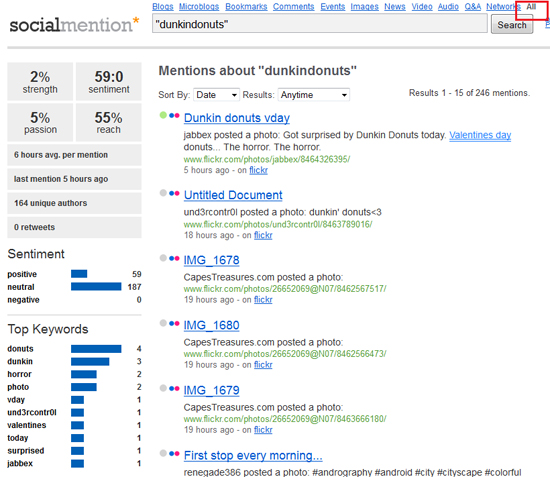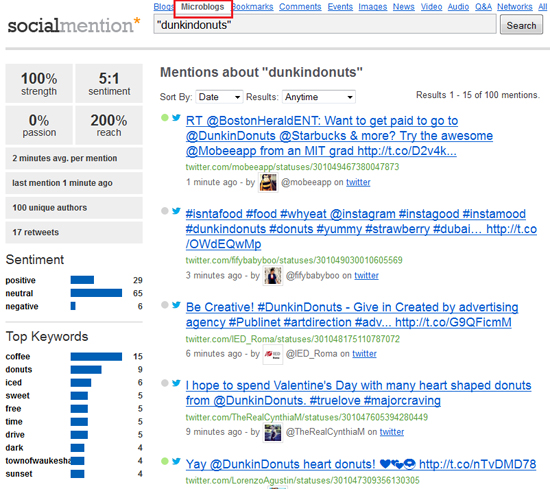Editor’s Note: This article was originally published by Web Marketing Today. Practical Ecommerce acquired Web Marketing Today in 2012. In 2016, we merged the two sites, leaving Practical Ecommerce as the successor.
Measuring social media effectiveness can seem daunting. It is less clear-cut and more complex than other, more traditional marketing channels. But measuring your social media efforts is possible, and it’s crucial to your overall marketing strategy. A better understanding of your social media efforts will help you discover which mediums and strategies work best and make adjustments accordingly.
6 Social Media Metrics
1. Brand Exposure
Building brand awareness is a critical goal for social media marketing. But gaining brand-awareness traction may be slow. After committing to a smart social strategy and dedicating your business to genuine engagement, you will attract a following, spotlighting your brand. Social media success can quickly accelerate. It is important to keep track of accomplishments, and analyze your efforts. Although there are no hard and fast rules for measuring exposure, there are social signals that you can track to gauge your brand exposure.
- Website traffic, including site visits and page views.
- Search data for branded keywords.
- Video and content views.
- Number of followers and fans.
- Number of blog and email subscribers.
2. Share of Voice and Sentiment
Share of voice is a measure of the number of social conversations about your brand in comparison to your competition. Tracking share of voice requires a social monitoring tool, which can help you keep tabs on all mentions of your brand and the brands of your competitors within a certain time frame. You should track positive, negative, and neutral sentiment and assign a weight to each of these categories to calculate the average sentiment regarding your business.
Social Mention is a good tool that can help you measure share of voice. Here is an example of how you can do this. Go to Social Mention and type in your company name in quotes — “organization name” — and click search. This will make sure you are using only exact, relevant matches. Select “all” in the pull-down menu next to the search box. On the results page you can see the total number of mentions at the top right as you can see below. You can adjust the date range to suit your needs. You should then scan through the mentions to get a feel for what is being said and by whom. This will help you put the mentions in proper context.

Social Mention lets you see what is being said about your business.
You can then click on the tabs to see mentions in specific social areas: Blogs, Microblogs, and Bookmarks.

Social Mention lets you search through specific areas of social media.
3. Influence
Influence is the measure of how much of what you do inspires action in others. When someone is exposed to messaging via a thought leader or influencer, the likelihood of engagement and lead conversion are amplified. An industry influencer is a trusted and credible informational resource with clout. Followers and fans listen attentively to the opinions, thoughts, ideas and recommendations of influencers. Individuals are more likely to pay close attention to a social message from an influencer. The likelihood that followers will agree with an influencer or take recommended actions is significantly higher than average. Here are some indicators of influence.
- Number and quality of inbound links to your content.
- Retweets, Twitter comments and Google “+1s”.
- “Likes,” shares, and comments of your Facebook posts.
- The extent that your content is shared or endorsed.
Analyzing influence will inform you to what degree you are able to motivate others to take action. To calculate, look at how many influencers mentioned you and the reach of their audiences. For example, if an influencer with 1 million followers tweets your content or mentions your brand, you can count this social interaction as an influencer impression with a reach of 1 million estimated impressions. You can calculate influence for blog posts and other social media mentions as well. Just determine the number of followers or readership for each influencer who engaged with your content or endorsed you or your business socially, and you can estimate the influence for each mention and act of engagement. Influencer impressions are likely to magnify reach and levels of engagement.
4. Engagement
Engagement measures how much others interact with you and your content on social media. High levels of engagement are proof that you have a following interested in what you are offering and eager to interact with your brand socially. This crucial metric can tie social media to audience action — highlighting its real value. Analyze engagement, so you can see how much and how often followers and fans interact with your content. Signs of engagement include the following.
- New Facebook Likes for your page or posts.
- Number of shares.
- Positive, negative, and neutral mentions.
- Blog comments.
- Ratings.
- Retweets.
5. Popularity
Online popularity is the number of people that subscribe to your content. Some marketers believe that the quality of your following is more important than the size of your subscribed audience, which is valid to some extent. However, if you are seeking advertisers or sponsors, having 13,000 Twitter followers would be more advantageous than having 900 more influential ones. Indicators of social media popularity include the following.
- Number of email/RSS subscribers.
- Number of Twitter followers.
- Number of members in your LinkedIn group.
- Number of people who Like your Facebook page.
- Number of people who have circled you on Google+.
- How many people are following your boards on Pinterest.
6. Lead Scoring and Social Conversion Rate
Measuring the lead activity you generate through social media is very important. Track visit-to-lead conversion. Although social media can drive traffic to your website, traffic alone is not a rainmaker. Determine — for each major social network and as a whole — how many visitors convert into leads. Knowing exactly how much social media contributes to your lead generation can help you create and reach a monthly goal. Understanding how much interest is generated on social channels will guide you in creating better social strategy and content.
Social Media Monitoring Tools
Both free and paid social media monitoring tools can be extremely helpful in your efforts to measure social media marketing. Here are my top ones to consider.
Top Paid Social Tools
Top Free Tools
Summary
Analyzing social media can be a challenge, but measurement and analysis is attainable. It just requires objectives, knowledge, and tools. Experiment with the various measurements explained above to discover which tools and social channels are most effective for your business. In-depth social insight can make a big difference in helping you streamline and fine-tune your strategies and achieve social media success.



